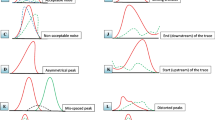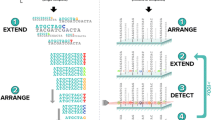Abstract
Background
21-Hydroxylase deficiency (21-OHD) is caused by pathogenic CYP21A2 variations. CYP21A2 is arranged in tandem with its highly homologous pseudogene CYP21A1P; therefore, it is prone to mismatch and rearrangement, producing different types of complex variations. There were few reports on using only one method to detect different CYP21A2 variants simultaneously.
Aims
Targeted long-read sequencing method was used to detect all types of CYP21A2 variants in a series of patients with 21-OHD.
Methods
A total of 59 patients with 21-OHD were enrolled from Peking Union Medical College Hospital. Long-range locus-specific PCR and long-read sequencing (LRS) were performed to detect the pathogenic variants in CYP21A2.
Results
Copy-number variants of CYP21A2 were found in 25.4% of patients, including 5.1% with 3 copies of CYP21A2, 16.9% with 1 copy of CYP21A2, and 3.4% with 0 copy of CYP21A2. The remaining 74.6% of patients had 2 copies of CYP21A2. Pathogenic variants were identified in all 121 alleles of 59 patients. Specifically, single-nucleotide variants and small insertions/deletions (< 50 bp) were detected in 79 alleles, of which conversed from CYP21A1P were detected in 63 alleles, and rare variants were found in the other 16 alleles. Large gene conversions (> 50 bp) from pseudogene were detected in 10 alleles, and different chimeric genes (CYP21A1P/CYP21A2 or TNXA/TNXB) formed by large deletions were detected in 32 alleles. Of all variants, p.I173N was the most common variant (19.0%).
Conclusions
Our study demonstrated that targeted long-read sequencing is a comprehensive method for detecting CYP21A2 variations, which is helpful for genetic diagnosis in 21-OHD patients.



Similar content being viewed by others
Data availability
The original contributions presented in the study are included in the article/supplementary files, and further inquiries can be directed to the corresponding author/s.
References
Merke DP, Bornstein SR (2005) Congenital adrenal hyperplasia. Lancet 365(9477):2125–2136
Krone N, Arlt W (2009) Genetics of congenital adrenal hyperplasia. Best Pract Res Clin Endocrinol Metab 23(2):181–192
Liu Y, Chen M, Liu J et al (2022) Comprehensive analysis of congenital adrenal hyperplasia using long-read sequencing. Clin Chem 68(7):927–939
Chen W, Xu Z, Sullivan A et al (2012) Junction site analysis of chimeric CYP21A1P/CYP21A2 genes in 21-hydroxylase deficiency. Clin Chem 58(2):421–430
Gao YJ, Yu BQ, Lu L et al (2019) Analysis of copy number variation of CYP21A2 gene and the type of CYP21A1P/CYP21A2 fused gene in patients with 21-hydroxylase deficiency. Zhonghua Yi Xue Za Zhi 99(48):3765–3769
Tolba A, Mandour I, Musa N et al (2022) Copy number variations in genetic diagnosis of congenital adrenal hyperplasia children. Front Genet 13:785570
Carrozza C, Foca L, De Paolis E et al (2021) Genes and pseudogenes: complexity of the RCCX locus and disease. Front Endocrinol (Lausanne) 12:709758
Maher Kharrat ARFM (2011) Detection of a frequent duplicated CYP21A2 gene carrying a Q318X mutation in a general population with quantitative PCR methods. Diagn Mol Pathol. https://doi.org/10.1097/PDM.0b013e3181f24807
Marino R, Ramirez P, Galeano J et al (2011) Steroid 21-hydroxylase gene mutational spectrum in 454 Argentinean patients: genotype-phenotype correlation in a large cohort of patients with congenital adrenal hyperplasia. Clin Endocrinol (Oxf) 75(4):427–435
New MI, Abraham M, Gonzalez B et al (2013) Genotype-phenotype correlation in 1,507 families with congenital adrenal hyperplasia owing to 21-hydroxylase deficiency. Proc Natl Acad Sci U S A 110(7):2611–2616
Krone N, Braun A, Roscher AA et al (2000) Predicting phenotype in steroid 21-hydroxylase deficiency? Comprehensive genotyping in 155 unrelated, well defined patients from southern Germany. J Clin Endocrinol Metab 85(3):1059–1065
Finkielstain GP, Kim MS, Sinaii N et al (2012) Clinical characteristics of a cohort of 244 patients with congenital adrenal hyperplasia. J Clin Endocrinol Metab 97(12):4429–4438
Krone N, Rose IT, Willis DS et al (2013) Genotype-phenotype correlation in 153 adult patients with congenital adrenal hyperplasia due to 21-hydroxylase deficiency: analysis of the United Kingdom Congenital adrenal Hyperplasia Adult Study Executive (CaHASE) cohort. J Clin Endocrinol Metab 98(2):E346–E354
Ling S, Xi Y, Jing C et al (2018) Clinical presentation and mutational spectrum in a series of 166 patients with classical 21-hydroxylase deficiency from South China. Clin Chim Acta 486:142
Hou L, Liang L, Lin S et al (2019) Analysis of phenotypes and genotypes in 84 patients with 21-Hydroxylase deficiency in southern China. Steroids 151:108474
Lee HH, Lee YJ, Wang YM et al (2008) Low frequency of the CYP21A2 deletion in ethnic Chinese (Taiwanese) patients with 21-hydroxylase deficiency. Mol Genet Metab 93(4):450–457
Dumic KK, Grubic Z, Yuen T et al (2017) Molecular genetic analysis in 93 patients and 193 family members with classical congenital adrenal hyperplasia due to 21-hydroxylase deficiency in Croatia. J Steroid Biochem Mol Biol 165(Pt A):51–56
Mahmoud RAA, Amr NH, Toaima NN et al (2021) Genotypic spectrum of 21-hydroxylase deficiency in an endogamous population. J Endocrinol Investing. 45(2):347
Wang R, Yu Y, Ye J et al (2016) 21-hydroxylase deficiency-induced congenital adrenal hyperplasia in 230 Chinese patients: genotype-phenotype correlation and identification of nine novel mutations. Steroids 108:47–55
Marino R, Ramirez P, Galeano J et al (2011) Steroid 21-hydroxylase gene mutational spectrum in 454 Argentinean patients: genotype-phenotype correlation in a large cohort of patients with congenital adrenal hyperplasia. Clin Endocrinol 75(4):427–435
Finkielstain GP, Chen W, Mehta SP et al (2011) Comprehensive genetic analysis of 182 unrelated families with congenital adrenal hyperplasia due to 21-hydroxylase deficiency. J Clin Endocrinol Metab 96(1):E161–E172
Acknowledgements
The authors would like to thank all patients and their family members for participating in the study.
Funding
This work was supported by National High Level Hospital Clinical Research Funding (2022-PUMCH-D-002), CAMS Innovation Fund for Medical Sciences (CIFMS 2021-I2M-1-003), National Natural Science Foundation of China (Grant No. 81971375), Natural Science Foundation of Beijing (Grant No. 7212080), and National High Level Hospital Clinical Research Funding (2022-PUMCH-C-028).
Author information
Authors and Affiliations
Contributions
MN designed and guided the experiments. XW, XW, and JM collected blood samples. SC, AT, and LL collected clinical data. YG, YC, BS, WZ, and XZ carried out the experiment. XZ and MN analyzed the experimental data and wrote the paper. All authors contributed to the article and approved the submitted version.
Corresponding author
Ethics declarations
Conflict of interest
The authors declare that the research was conducted in the absence of any commercial or financial relationships that could be construed as a potential conflict of interest.
Research involving human participants and/or animals
The present study was approved by the ethics committee of Peking Union Medical College Hospital.
Informed consent
Informed consent was obtained from all individual participants included in the study.
Additional information
Publisher's Note
Springer Nature remains neutral with regard to jurisdictional claims in published maps and institutional affiliations.
Rights and permissions
Springer Nature or its licensor (e.g. a society or other partner) holds exclusive rights to this article under a publishing agreement with the author(s) or other rightsholder(s); author self-archiving of the accepted manuscript version of this article is solely governed by the terms of such publishing agreement and applicable law.
About this article
Cite this article
Zhang, X., Gao, Y., Lu, L. et al. Targeted long-read sequencing for comprehensive detection of CYP21A2 mutations in patients with 21-hydroxylase deficiency. J Endocrinol Invest 47, 833–841 (2024). https://doi.org/10.1007/s40618-023-02197-y
Received:
Accepted:
Published:
Issue Date:
DOI: https://doi.org/10.1007/s40618-023-02197-y




